1) 鑌 嶚抾恾丂柫 戝姲挿丂丂
Design: Bamboo leaves by Otaka Hironaga.
SOLD |
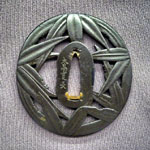 |
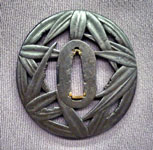 |
1) 鑌 嶚抾恾丂柫 戝姲挿丂丂
悺朄丗廲75.0亊墶71.0亊岤偝5.0 (mm)丂
夝愢丗抾偼忢椢偱偁傝孅偡傞偙偲側偔嫮偔恀捈偖怢傃傞偙偲偐傜亀晄孅丒愡憖亁堄枴偟丄
晲巑偵垽偝傟偰偒偨丅擔杮偱偼擭偺曢13擔丄嶚抾傪梡偄偨攣暐偄偲偄偆惓寧傪寎偊傞
弨旛傪奐巒偡傞揱摑峴帠偑偁傝丄恄惞側擔偱偁偭偨丅揝枴偲挙傝偑椙偄丅
嵒愳惓廃丒攏柺彉惌栧丅
峕屗帪戙屻婜丅(19悽婭) 曐懚娪掕彂晅丅
Design: Bamboo leaves by Otaka Hironaga.
This Tsuba was made by Otaka Hironaga in 19th century, Edo period.
Bamboo design is loved by Samurai as symbol of fortitude and constancy.
He is a pupil of Sunagawa Masahiro and Bamen Tsunemasa. 19th century.
Hozon certificate paper.
|
2) 鑌丂媏壴婂摟恾丂嫗摟
Design: Chrysanthemum with wild geese.
SOLD |
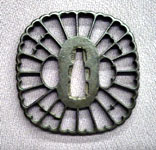 |
2) 鑌丂媏壴婂摟恾丂嫗摟
悺朄丗廲75.0亊墶75.0亊岤偝5.0 (mm)丂
夝愢丗媏偼屆棃傛傝峜幒偲怺偄寢傃偮偒偑偁傝丄嬎偲嫟偵峜幒偺栦復偲偟偰傕巊梡偝傟偰偄傞丅
傑偨丄偦偺惗柦椡偺嫮偝偐傜丄挿庻偺徾挜偲偟偰斏塰傪婅偆晲壠偵傕戝曄岲傑傟偨丅
戝嬻傪巚傢偣傞媏壴傪慇嵶側慄偱摟偟丄巐曽偵搉棃偡傞婂傪攝偟偰堷偒掲傔偨峔恾偵
巇忋偘偰偄傞丅廐嬻偺応宨傪巚偄晜偐偽偣偰偔傟傞煭棊偨堩昳丅
搷嶳帪戙枛婜(16悽婭)丅摿暿曐懚娪掕彂晅丅
Design: Chrysanthemum with wild geese.
Chrysanthemum was belonged to Imperial Family and has deep relationship
with them.
And it was also loved aristocrat and upper-class Samurai as a symbol of strong life
and prosperity of own family.
This chrysanthemum was represented with elegant open work and migratory
birds,
wild geese are decorated in all directions on the Tsuba. We can visualize
autumn sky
from this design and is very elegant and unique composition.
16th century. Tokubetsu Hozon certificate paper.
|
3) 媏壴摟恾丂柍柫 憗壋彈丂
Design of a 64 petals chrysanthemum open work by Saotome School
SOLD |
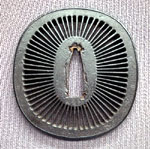 |
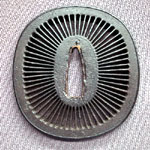 |
3) 鑌 媏壴摟恾丂柍柫 憗壋彈丂
悺朄丗廲81.0亊墶76.5亊岤偝5.0 (mm)
夝愢丗忢棨崙(尰嵼偺堬忛導)偵嫃廧偟偰偄偨憗壋彈攈偼丄峛檋巘弌恎偱偁傞偙偲偐傜
戩墇偟偨惛楤媄弍傪鑌惢嶌偵傕敪婗偟偨丅杮嶌傕丄榋廫巐梩偺媏壴傪惛楤偝傟偨揝抧偵
摟偐偟丄愒摵暍椫傪巤偟偰偄傞丅烠寠偑側偔丄峕屗慜婜偺嶌偲峫偊傜傟傞丅曐懚娪掕彂晅丅
Design of a 64 petals chrysanthemum open work by Saotome School
which is from armor maker in Hitachi province (present Ibaraki prefecture).
This prominent armor school shows their high technique to forge an iron for also Tsuba making.
This is well-forged old iron work, has no Hitsu-ana hole and covered by Shakudo rim.
17th century. Hozon certificate paper.
|
4) 墢摢 悂婑恾丂柫 屻摗朄嫶搶忔(壴墴)
Design: Scene of flowing fallen leaves by Goto Tojo
SOLD |
 |
 |
4) 墢摢 悂婑恾丂柫 屻摗朄嫶搶忔(壴墴)
悺朄丗(墢) 廲38.0亊墶21.5亊岤偝11.0 (mm)丂(摢) 廲34.0亊墶18.0亊岤偝7.0 (mm)
夝愢丗悂婑偣偲偼棊偪梩偑晽偵悂偒廤傔傜傟傞偙偲傪巜偡丅
愒摵嫑巕抧偵嬧埱傗晼側偳偑嵶偐偔昞尰偝傟偰偍傝
斢廐偺搤傪寎偊偨応宨偑椙偔尒偰庢傟傞丅
嶌幰偺屻摗搶忔(1790-1862)偼壛廈慜揷壠偵巇偊嫗搒偲嬥戲傪墲棃偟偰偄偨丅
峕屗帪戙屻婜丅(19悽婭) 曐懚娪掕彂晅丅
Design: Scene of flowing fallen leaves by Goto Tojo
We can enjoy the scene of changing the season from autumn to winter.
This Fuchi-Kashira was made by Goto Tojo (1790-1862)
who worked for lord Maeda family in Kaga province (Ishikawa pref.).
19th century. Hozon certificate paper.
|
5) 墢摢 嬬帣恾
Design: Playing puppy.
SOLD
|
 |
5) 墢摢 嬬帣恾丂
悺朄丗(墢) 廲38.0亊墶22.0亊岤偝9.0 (mm)丂(摢) 廲34.0亊墶19.0亊岤偝10.0 (mm)
夝愢丗杮嶌偼愒摵嫑巕抧偑旤偟偔丄搤偱傕尦婥偵梀傫偱偄傞巕將偑壜垽傜偟偄丅
廫擇巟偺堦偮偵傕側偭偰偄傞將偲恖娫偲偺寢傃晅偒偼屆偔丄偦偺垽傜偟偄巔偐傜傕岲夋戣偲偟偰
妝偟傑傟偰偄傞丅峕屗帪戙拞婜(18悽婭)丅
Design: Playing puppy.
This is an elegant shakudo-nanako work and playing puppy is so enjoyable.
A dog which is one of the twelve signs of the zodiac and the human relations is so old,
and its charming figure attracts the people since old times. 18th century.
|
6) 鉅 戦彔摴嬶恾 柫 屻摗岝棟(壴墴)丂
Design: Tools for falconry by Goto Mitsumasa
SOLD |

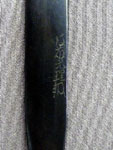
|
6) 鉅 戦彔摴嬶恾 柫 屻摗岝棟(壴墴)
悺朄丗廲13.0亊墶212.0(mm)丂
夝愢丗暯埨帪戙埲崀丄戦庪傝偼揤峜丄婱懓傪偼偠傔丄晲壠(彨孯傗戝柤)偺娫偱傕抌楤傪寭偹偰
惙傫偵峴傢傟偨丅杮嶌偼屻摗廆壠12戙栚屻摗岝棟(1695-1742)偵傛傞桪昳丅
峕屗帪戙拞婜丅(18悽婭) 曐懚娪掕彂晅丅
Design: Tools for falconry by Goto Mitsumasa
Falconry has been taking place by the Imperial family and an aristocrat
from Heian period.
And it is also popular among a Shogun and a lord in Edo period as military arts.
This is made by Goto Mitsumasa who is the 12th mainline master of Goto School in 18th century. Hozon certificate paper.
|